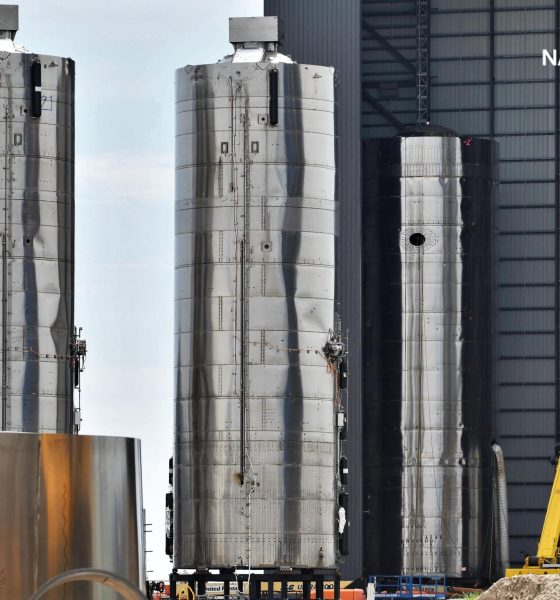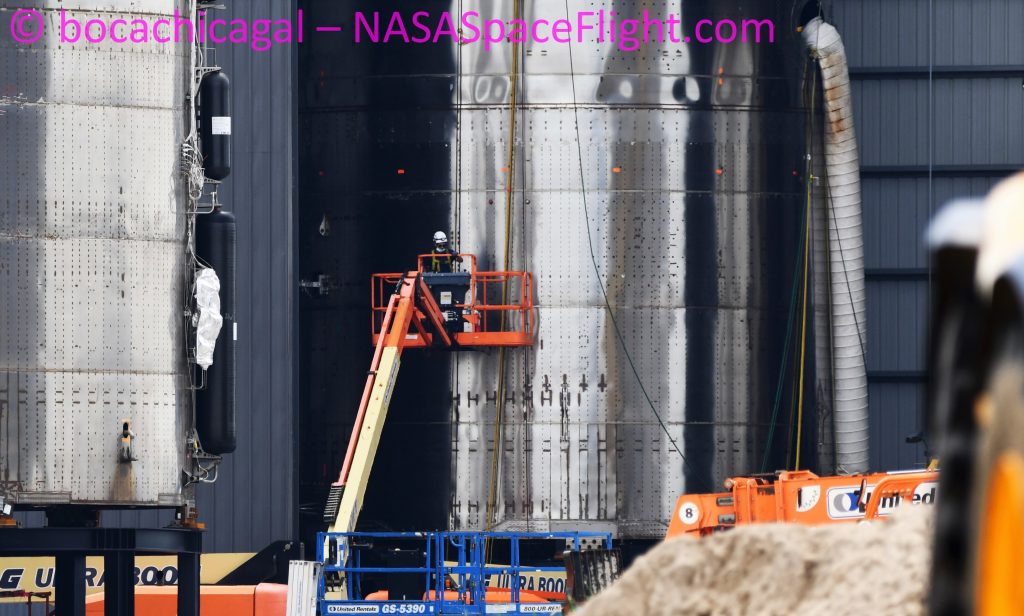

News
SpaceX’s first high-altitude Starship a week away from completion, says Elon Musk
CEO Elon Musk says that SpaceX’s first high-altitude Starship prototype – built entirely out of a new steel alloy – will be fully assembled “about a week” from now.
On August 4th, SpaceX successfully hopped a full-scale Starship prototype (serial number 5 or SN5) for the first time, reaching the same 150m (~500 ft) apogee Starhopper soared to just shy of one year prior. On September 3rd, just 30 days later, Starship SN6 – an entirely different full-scale prototype with a different Raptor engine – completed an identical 150m hop, though Musk noted that it was “a much smoother & faster operation.” Indeed, the whole purpose of performing the same hop with two nearly identical ships was to develop and optimize the nascent process of Starship flight testing.
Musk’s indication that “several” short hops would be performed strongly implied that SN5, SN6, or both ships would fly a second time. Now, though, Musk – supported by a NASASpaceflight.com report – appears to be suggesting that the first high-altitude Starship (SN8) is up next on the docket.

According to NASASpaceflight, SpaceX is now working towards the first high-altitude launch of Starship SN8 as early as October. Prior to that ambitious test flight, though, several critical milestones stand in the way. Unmentioned, Starship test tank SN7.1 may be hours away from kicking off a cryogenic stress test crucial to the future of Starship SN8 and several of its successors. Built out of a steel alloy that is somewhat more ductile and pliable at cryogenic temperatures, a successful SN7.1 stress test would open the door for SN8 – the first full-scale prototype built out of the same new alloy – to begin testing immediately thereafter.
As with all tests, though, failure is a strong possibility and would likely require more analysis of the new steel alloy and some level of redesign for several affected Starship components. In that event, Starship SN8 would likely serve as a test tank instead of becoming the first high-altitude flight article. SN7.1’s trials are set to begin no earlier than (NET) 9pm CDT (UTC-5) on September 14th and could continue all the way up to September 23rd.


Meanwhile, SpaceX is working around the clock to outfit Starship SN8 and prepare the ship for the installation of a nosecone section and four aerodynamic control surfaces known as flaps. Unlike Starship Mk1, which was temporarily outfitted with flaps and a nosecone more as a full-size mockup than a flight article, there is a very real chance that Starship SN8 will actually perform a flight test with its nose and flaps installed.
Unlike the Space Shuttle or other proposed spaceplanes, SpaceX’s current Starship design incorporates flaps to ensure aerodynamic stability while free-falling belly-first through the atmosphere, akin to a skydiver using arms and legs to steer through the air.
If Musk’s schedule is accurate, Starship SN8 could be fully outfitted with a nosecone and flaps and ready to roll to the launch pad for testing as early as next week. Prior to the first 20 km (~12.5 mi) hop and skydiver-style landing attempt, Musk says that SpaceX will put SN8 through a static fire test (possibly the first with three Raptor engines). If it survives, the rocket will be carefully inspected before performing a second static fire test. If that second test is successful, SN8 will finally be cleared for Starship’s first high-altitude launch and landing attempt.
Check out Teslarati’s Marketplace! We offer Tesla accessories, including for the Tesla Cybertruck and Tesla Model 3.

Elon Musk
Elon Musk and Tesla AI Director share insights after empty driver seat Robotaxi rides
The executives’ unoccupied tests hint at the rapid progress of Tesla’s unsupervised Robotaxi efforts.

Tesla CEO Elon Musk and AI Director Ashok Elluswamy celebrated Christmas Eve by sharing personal experiences with Robotaxi vehicles that had no safety monitor or occupant in the driver’s seat. Musk described the system’s “perfect driving” around Austin, while Elluswamy posted video from the back seat, calling it “an amazing experience.”
The executives’ unoccupied tests hint at the rapid progress of Tesla’s unsupervised Robotaxi efforts.
Elon and Ashok’s firsthand Robotaxi insights
Prior to Musk and the Tesla AI Director’s posts, sightings of unmanned Teslas navigating public roads were widely shared on social media. One such vehicle was spotted in Austin, Texas, which Elon Musk acknowleged by stating that “Testing is underway with no occupants in the car.”
Based on his Christmas Eve post, Musk seemed to have tested an unmanned Tesla himself. “A Tesla with no safety monitor in the car and me sitting in the passenger seat took me all around Austin on Sunday with perfect driving,” Musk wrote in his post.
Elluswamy responded with a 2-minute video showing himself in the rear of an unmanned Tesla. The video featured the vehicle’s empty front seats, as well as its smooth handling through real-world traffic. He captioned his video with the words, “It’s an amazing experience!”
Towards Unsupervised operations
During an xAI Hackathon earlier this month, Elon Musk mentioned that Tesla owed be removing Safety Monitors from its Robotaxis in Austin in just three weeks. “Unsupervised is pretty much solved at this point. So there will be Tesla Robotaxis operating in Austin with no one in them. Not even anyone in the passenger seat in about three weeks,” he said. Musk echoed similar estimates at the 2025 Annual Shareholder Meeting and the Q3 2025 earnings call.
Considering the insights that were posted Musk and Elluswamy, it does appear that Tesla is working hard towards operating its Robotaxis with no safety monitors. This is quite impressive considering that the service was launched just earlier this year.
Elon Musk
Starlink passes 9 million active customers just weeks after hitting 8 million
The milestone highlights the accelerating growth of Starlink, which has now been adding over 20,000 new users per day.

SpaceX’s Starlink satellite internet service has continued its rapid global expansion, surpassing 9 million active customers just weeks after crossing the 8 million mark.
The milestone highlights the accelerating growth of Starlink, which has now been adding over 20,000 new users per day.
9 million customers
In a post on X, SpaceX stated that Starlink now serves over 9 million active users across 155 countries, territories, and markets. The company reached 8 million customers in early November, meaning it added roughly 1 million subscribers in under seven weeks, or about 21,275 new users on average per day.
“Starlink is connecting more than 9M active customers with high-speed internet across 155 countries, territories, and many other markets,” Starlink wrote in a post on its official X account. SpaceX President Gwynne Shotwell also celebrated the milestone on X. “A huge thank you to all of our customers and congrats to the Starlink team for such an incredible product,” she wrote.
That growth rate reflects both rising demand for broadband in underserved regions and Starlink’s expanding satellite constellation, which now includes more than 9,000 low-Earth-orbit satellites designed to deliver high-speed, low-latency internet worldwide.
Starlink’s momentum
Starlink’s momentum has been building up. SpaceX reported 4.6 million Starlink customers in December 2024, followed by 7 million by August 2025, and 8 million customers in November. Independent data also suggests Starlink usage is rising sharply, with Cloudflare reporting that global web traffic from Starlink users more than doubled in 2025, as noted in an Insider report.
Starlink’s momentum is increasingly tied to SpaceX’s broader financial outlook. Elon Musk has said the satellite network is “by far” the company’s largest revenue driver, and reports suggest SpaceX may be positioning itself for an initial public offering as soon as next year, with valuations estimated as high as $1.5 trillion. Musk has also suggested in the past that Starlink could have its own IPO in the future.
News
NVIDIA Director of Robotics: Tesla FSD v14 is the first AI to pass the “Physical Turing Test”
After testing FSD v14, Fan stated that his experience with FSD felt magical at first, but it soon started to feel like a routine.

NVIDIA Director of Robotics Jim Fan has praised Tesla’s Full Self-Driving (Supervised) v14 as the first AI to pass what he described as a “Physical Turing Test.”
After testing FSD v14, Fan stated that his experience with FSD felt magical at first, but it soon started to feel like a routine. And just like smartphones today, removing it now would “actively hurt.”
Jim Fan’s hands-on FSD v14 impressions
Fan, a leading researcher in embodied AI who is currently solving Physical AI at NVIDIA and spearheading the company’s Project GR00T initiative, noted that he actually was late to the Tesla game. He was, however, one of the first to try out FSD v14.
“I was very late to own a Tesla but among the earliest to try out FSD v14. It’s perhaps the first time I experience an AI that passes the Physical Turing Test: after a long day at work, you press a button, lay back, and couldn’t tell if a neural net or a human drove you home,” Fan wrote in a post on X.
Fan added: “Despite knowing exactly how robot learning works, I still find it magical watching the steering wheel turn by itself. First it feels surreal, next it becomes routine. Then, like the smartphone, taking it away actively hurts. This is how humanity gets rewired and glued to god-like technologies.”
The Physical Turing Test
The original Turing Test was conceived by Alan Turing in 1950, and it was aimed at determining if a machine could exhibit behavior that is equivalent to or indistinguishable from a human. By focusing on text-based conversations, the original Turing Test set a high bar for natural language processing and machine learning.
This test has been passed by today’s large language models. However, the capability to converse in a humanlike manner is a completely different challenge from performing real-world problem-solving or physical interactions. Thus, Fan introduced the Physical Turing Test, which challenges AI systems to demonstrate intelligence through physical actions.
Based on Fan’s comments, Tesla has demonstrated these intelligent physical actions with FSD v14. Elon Musk agreed with the NVIDIA executive, stating in a post on X that with FSD v14, “you can sense the sentience maturing.” Musk also praised Tesla AI, calling it the best “real-world AI” today.








